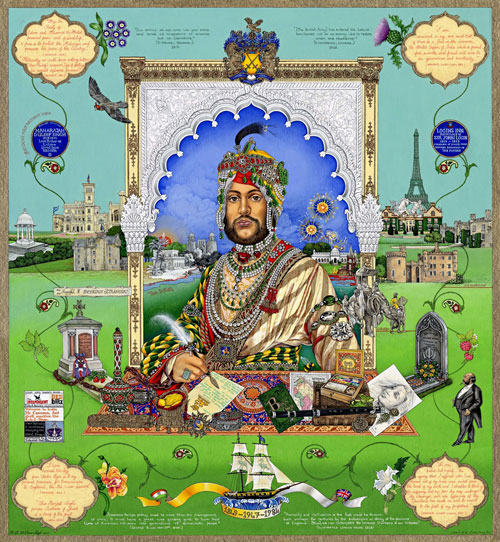|
|
The South
Asian Life & Times - SALT |
|
|||
|
Contents Feature Heritage People
Book Reviews Kaavad
Traditions of Rajasthan
- exploring
|
|
||||
|
CASUALTY OF WAR: Portrait of Maharajah Duleep Singh
By The
Singh Twins
In 1854, Queen Victoria commissioned her
court artist, Franz Xaver Winterhalter, to paint a portrait of 15-year-old
Duleep Singh, the last Maharaja of the Sikh empire, who had just been
brought to the UK after having been forced to surrender his sovereignty to
Britain. Now, 160 years later, the National Museum of Scotland, commissioned
the Liverpool based artists The Singh Twins to make another portrait of the
Maharaja. The Singh Twins call their art work ‘Casualty of War: A Portrait
of Maharaja Duleep Singh.’ They have painted a narrative of the tragic life
of the ‘Black Prince of Perthshire’ – as the Maharaja came to be known.
“We’ve been making work about Duleep Singh since
the 90s,” the Singh Twins say. “His story is so tragic. He has become a
figurehead for Sikhs, a poignant symbol of what we once had and lost.”
The Singh Twins share the extraordinary story of
the making of the painting with SALT. This painting was inspired by a group of artefacts
(mostly jewellery) in the National Museum of Scotland collections that are
associated with Maharaja Duleep Singh. Essentially, it depicts the man
behind these artefacts. But rather than being a straightforward portrait, it
paints a narrative of his life, times and legacy to provide a context for
exploring what these artefacts represent from different perspectives. That
is, not just as the once personal property of a Sikh Maharaja now in public
British possession, but as material objects belonging to a specific culture
and time – namely, that of pre-Partition India, Colonialism and the Sikh
Empire. Interwoven into this visual history is Duleep Singh’s special
connection with Sir John Login, an individual who, possibly more than any
other, influenced Duleep Singh’s early upbringing. And whose involvement
with the Maharaja, both as his guardian and as a key player in British
interests in India, reflected the ambiguous nature of Duleep Singh’s
relationship with the British establishment. On the one hand, it shows
Duleep Singh’s importance as an historical figure of tremendous significance
and global relevance whose life story is inextricably tied to and helped
shaped British-Indian, Punjabi, Anglo-Sikh history, politics and culture,
past and present. On the other hand, it depicts Duleep Singh as a tragic,
human figure. An innocent individual and victim of circumstance who became a
casualty of war, caught up in the power games and politics of the British
Empire. Overall, it is a tribute to the Maharaja who became Britain’s first
resident Sikh. Appropriately, this landmark event in Britain’s history
celebrated its 160th anniversary in November 2014, the same year the
painting was officially unveiled by the National Museum of Scotland.
|
|||||
|
Copyright © 2000 - 2015 [the-south-asian.com]. Intellectual Property. All rights reserved. |
|||||
